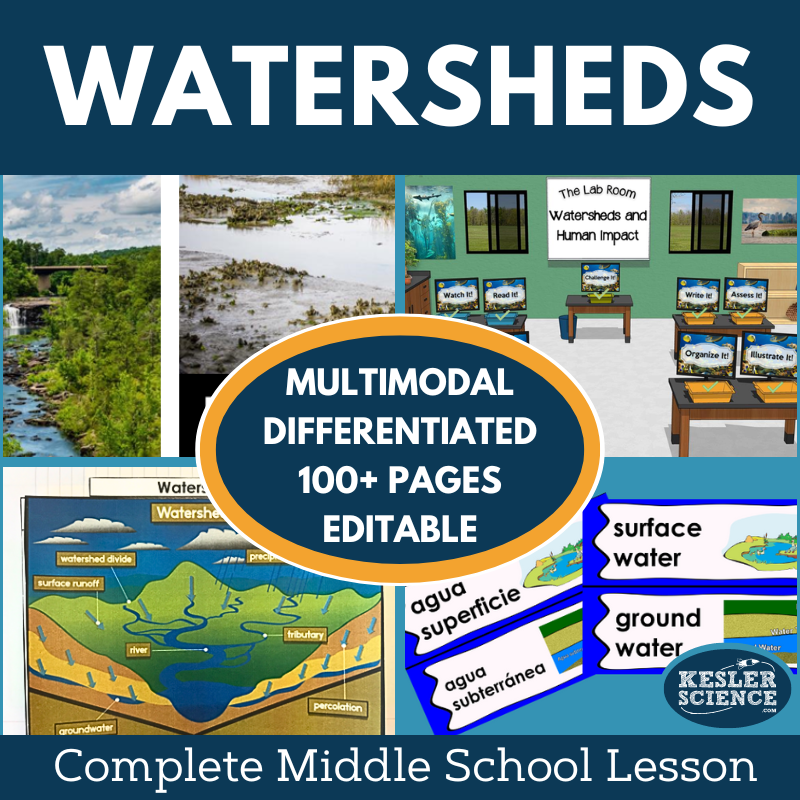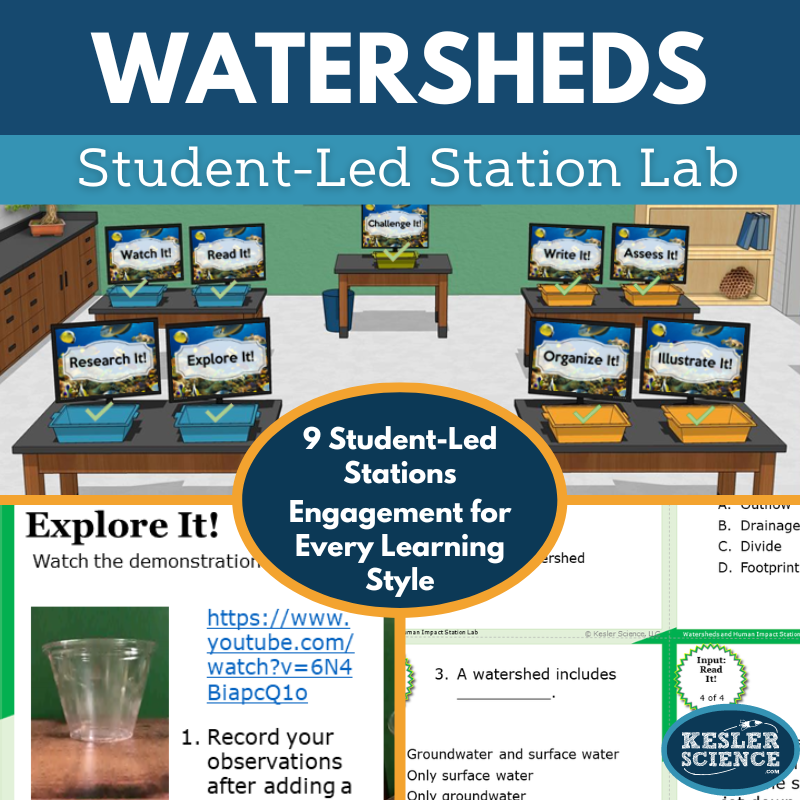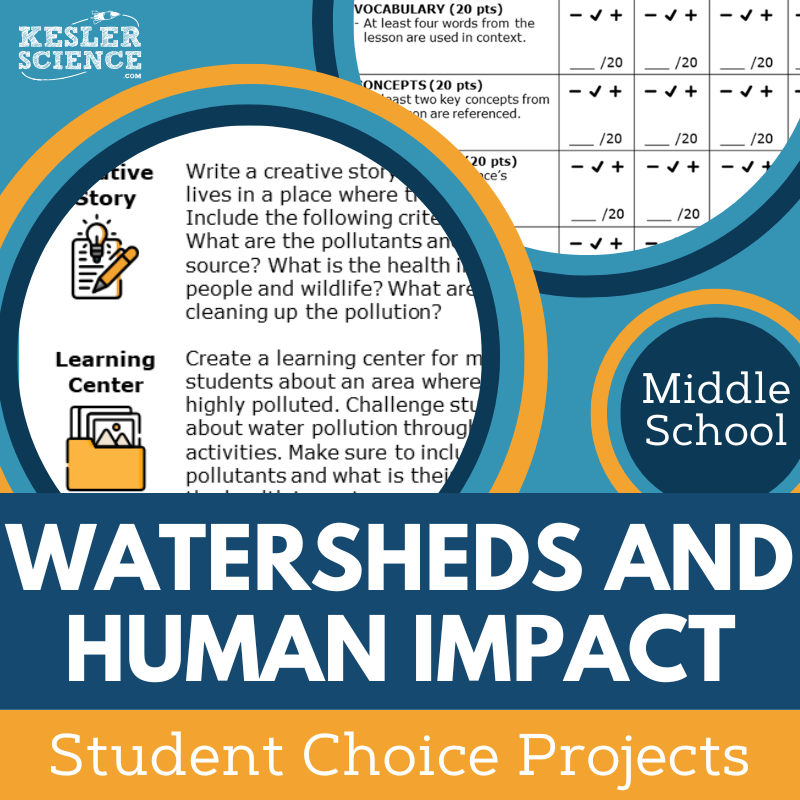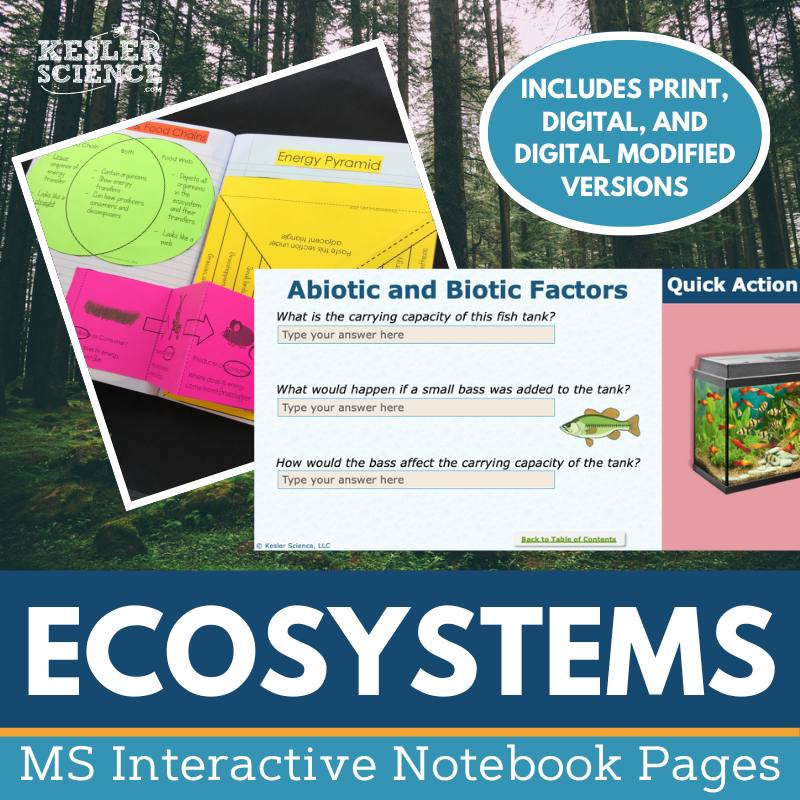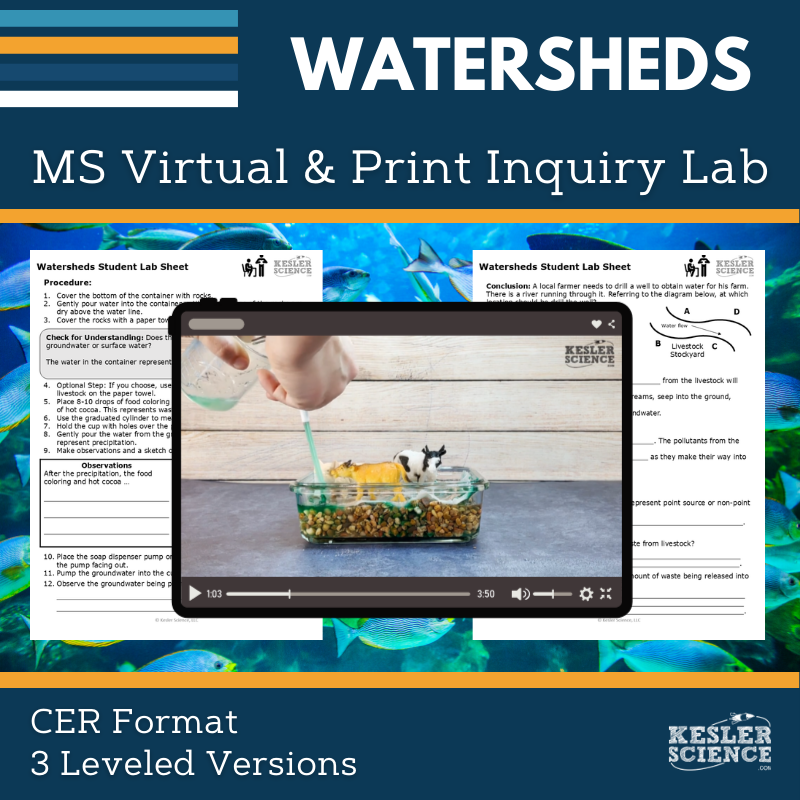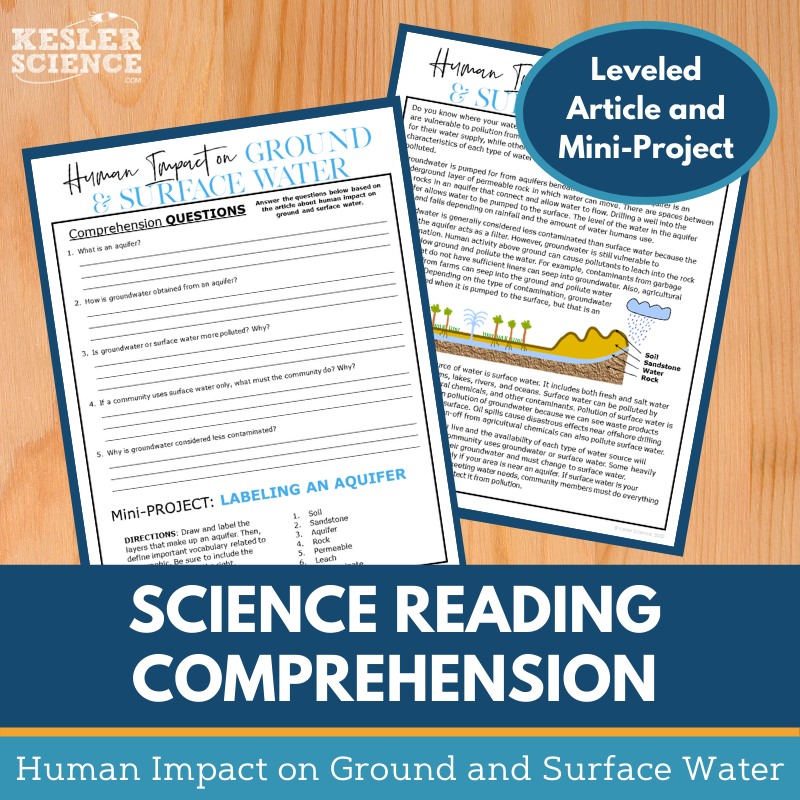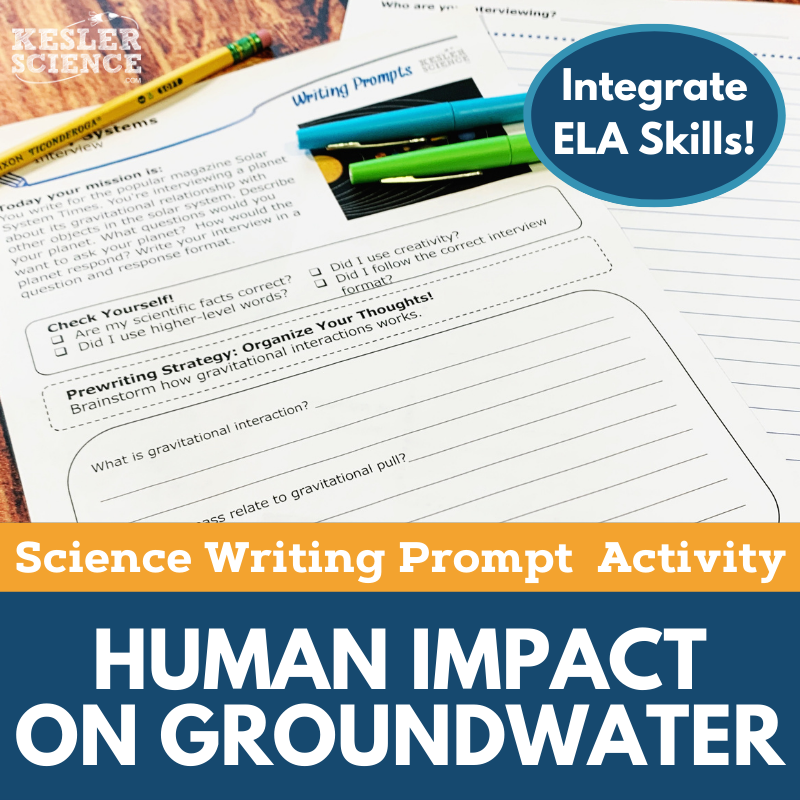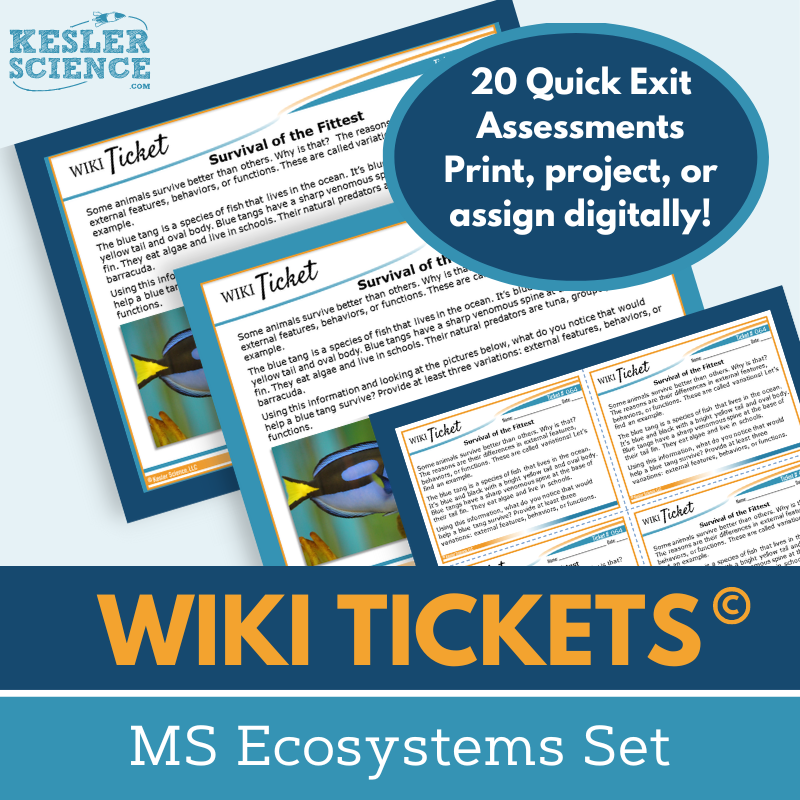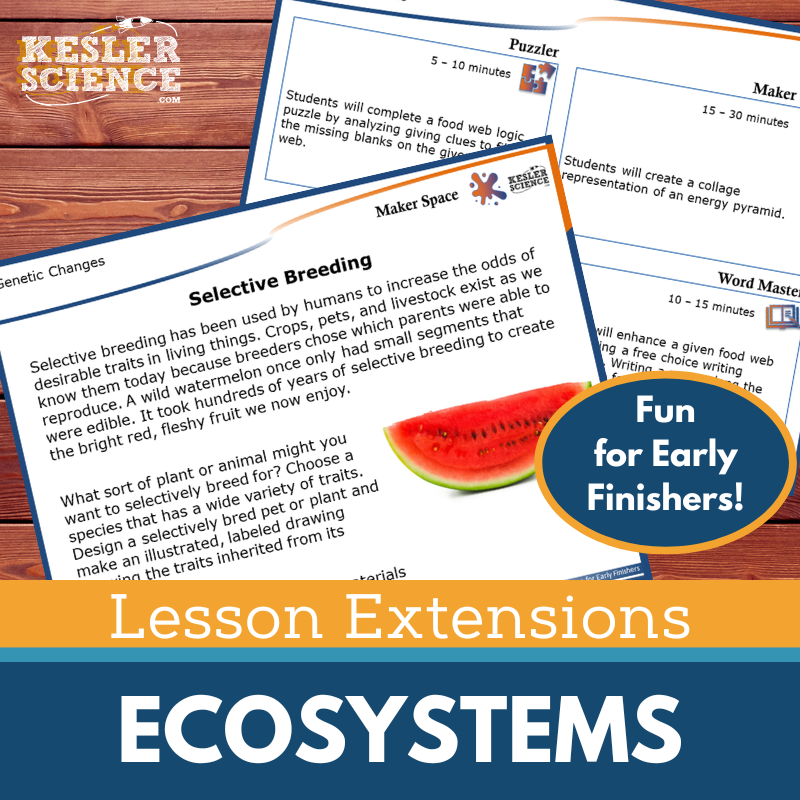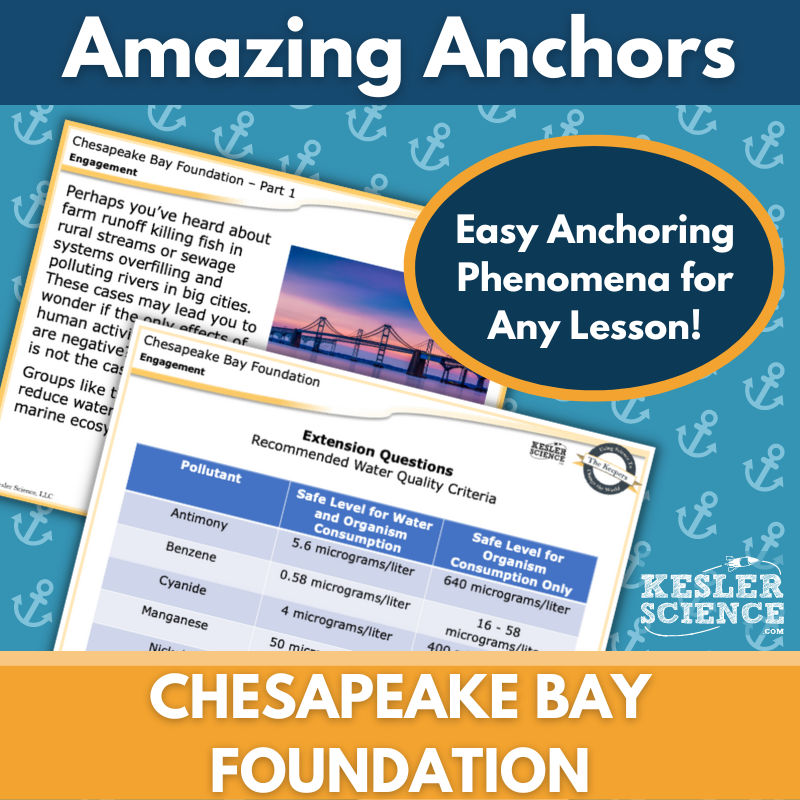Watersheds and Human Impact Activities for Middle School Science
The Kesler Science Watersheds resources offer a comprehensive, student-centered approach to teaching about watersheds, their components, and the human impact on water systems. The resources below will give students a comprehensive understanding of watersheds and human impact. All of the following materials are also included in the Kesler Science Membership.
The Kesler Science Watersheds and Human Impact Complete 5E Lesson offers everything needed for a dynamic, multi-day lesson on watersheds, designed for 6th-8th grade students. The lesson uses the 5E model—Engagement, Exploration, Explanation, Elaboration, and Evaluation—to encourage student-led learning with minimal prep. The lesson is fully differentiated, offering resources for students who need support and extensions for those seeking a challenge. With materials available in both printable and digital formats, this lesson is flexible for all learning environments, including virtual classrooms.
The Exploration phase involves a student-led station lab with nine differentiated stations. These stations engage students with multiple learning modalities, including hands-on experiments, reading passages, research, videos, and creative output options like drawing and writing. The stations also include a bonus challenge for early finishers, allowing for additional learning opportunities. This structure ensures all students, regardless of their learning style, can explore watersheds and their environmental impacts in a meaningful way.
In the Explanation phase, students dive deeper into the material with editable PowerPoints, interactive notebooks, and note-taking templates. The Elaboration phase encourages students to apply their knowledge through student-choice projects, which they can complete in-class or at home. Finally, in the Evaluation phase, assessments and review materials, including modified versions, allow teachers to gauge student understanding and provide necessary feedback. This comprehensive lesson ensures that students build a strong understanding of watersheds while exploring human impact and water conservation.
The Kesler Science Watersheds and Human Impact Complete 5E Lesson offers everything needed for a dynamic, multi-day lesson on watersheds, designed for 6th-8th grade students. The lesson uses the 5E model—Engagement, Exploration, Explanation, Elaboration, and Evaluation—to encourage student-led learning with minimal prep. The lesson is fully differentiated, offering resources for students who need support and extensions for those seeking a challenge. With materials available in both printable and digital formats, this lesson is flexible for all learning environments, including virtual classrooms.
The Exploration phase involves a student-led station lab with nine differentiated stations. These stations engage students with multiple learning modalities, including hands-on experiments, reading passages, research, videos, and creative output options like drawing and writing. The stations also include a bonus challenge for early finishers, allowing for additional learning opportunities. This structure ensures all students, regardless of their learning style, can explore watersheds and their environmental impacts in a meaningful way.
In the Explanation phase, students dive deeper into the material with editable PowerPoints, interactive notebooks, and note-taking templates. The Elaboration phase encourages students to apply their knowledge through student-choice projects, which they can complete in-class or at home. Finally, in the Evaluation phase, assessments and review materials, including modified versions, allow teachers to gauge student understanding and provide necessary feedback. This comprehensive lesson ensures that students build a strong understanding of watersheds while exploring human impact and water conservation.
The Kesler Science Watersheds Station Lab provides a modular, student-led learning experience where middle school students can explore the characteristics of watersheds. With eight differentiated activities and a challenge station for early finishers, the stations are designed to foster independent learning while allowing students to engage with hands-on tasks. The teacher’s role is to facilitate the learning process rather than direct it, ensuring students take ownership of their education.
The lab includes nine stations with multimodal input and output opportunities. Stations like “Explore It!” offer hands-on demonstrations, while “Research It!” and “Read It!” help students gather information through websites and reading passages, which are available in both English and Spanish. Other stations like “Illustrate It!” and “Write It!” provide students with ways to synthesize and communicate their knowledge through sketches and short-answer responses.
The station lab is flexible for various learning environments, including in-person or virtual learning. The resources include task cards, signage, literature, and other materials, which can be easily adapted to different classroom settings. The digital versions, such as PowerPoint or Google Slides, allow students to engage with the materials remotely, ensuring accessibility for all students, whether in school or at home.
The Kesler Science Watersheds Station Lab provides a modular, student-led learning experience where middle school students can explore the characteristics of watersheds. With eight differentiated activities and a challenge station for early finishers, the stations are designed to foster independent learning while allowing students to engage with hands-on tasks. The teacher’s role is to facilitate the learning process rather than direct it, ensuring students take ownership of their education.
The lab includes nine stations with multimodal input and output opportunities. Stations like “Explore It!” offer hands-on demonstrations, while “Research It!” and “Read It!” help students gather information through websites and reading passages, which are available in both English and Spanish. Other stations like “Illustrate It!” and “Write It!” provide students with ways to synthesize and communicate their knowledge through sketches and short-answer responses.
The station lab is flexible for various learning environments, including in-person or virtual learning. The resources include task cards, signage, literature, and other materials, which can be easily adapted to different classroom settings. The digital versions, such as PowerPoint or Google Slides, allow students to engage with the materials remotely, ensuring accessibility for all students, whether in school or at home.
The Kesler Science Watersheds and Human Impact Student Choice Projects allow middle school students to choose from multiple project options that align with their learning style. The lesson offers nine project choices, including a “design your own” option, all supported by a clear grading rubric that can be modified to meet teachers’ specific needs. This flexible, student-centered approach empowers students to demonstrate their understanding in creative and personalized ways.
The projects come with teacher directions to guide implementation and editable rubric pages that assess vocabulary, concepts, clarity, presentation, and accuracy. This ensures both teachers and students can assess the work effectively. The projects offer a variety of options, including differentiated versions to support learners requiring additional help and more challenging versions for advanced students.
The projects require basic classroom supplies, such as paper, markers, and scissors, with many projects also being suitable for digital completion. Teachers can adapt the materials and resources to meet the needs of their class, making this activity a versatile and accessible way for students to explore human impacts on watersheds.
The Kesler Science Watersheds and Human Impact Student Choice Projects allow middle school students to choose from multiple project options that align with their learning style. The lesson offers nine project choices, including a “design your own” option, all supported by a clear grading rubric that can be modified to meet teachers’ specific needs. This flexible, student-centered approach empowers students to demonstrate their understanding in creative and personalized ways.
The projects come with teacher directions to guide implementation and editable rubric pages that assess vocabulary, concepts, clarity, presentation, and accuracy. This ensures both teachers and students can assess the work effectively. The projects offer a variety of options, including differentiated versions to support learners requiring additional help and more challenging versions for advanced students.
The projects require basic classroom supplies, such as paper, markers, and scissors, with many projects also being suitable for digital completion. Teachers can adapt the materials and resources to meet the needs of their class, making this activity a versatile and accessible way for students to explore human impacts on watersheds.
The Kesler Science Ecosystems Interactive Notebook Bundle provides an engaging and interactive way for students to explore key ecosystems concepts. Designed for flexibility, the resource includes both print and digital versions, making it suitable for traditional classrooms, 1:1 environments, and distance learning settings.
The bundle covers a wide range of topics, including biotic and abiotic factors, biomes, food webs, symbiosis, and the nitrogen and carbon cycles. Digital features include a unique interactive notebook PowerPoint, editable Google Slides compatibility, reflection pages, and modified versions for students with accommodations. The paper version includes blank and pre-filled templates, complete with color examples to guide students and teachers.
This resource supports differentiated instruction and accommodates all learners with thoughtfully designed templates and modifications. Whether in person or online, the Ecosystems Interactive Notebook promotes active learning, critical thinking, and scientific literacy.
The Kesler Science Ecosystems Interactive Notebook Bundle provides an engaging and interactive way for students to explore key ecosystems concepts. Designed for flexibility, the resource includes both print and digital versions, making it suitable for traditional classrooms, 1:1 environments, and distance learning settings.
The bundle covers a wide range of topics, including biotic and abiotic factors, biomes, food webs, symbiosis, and the nitrogen and carbon cycles. Digital features include a unique interactive notebook PowerPoint, editable Google Slides compatibility, reflection pages, and modified versions for students with accommodations. The paper version includes blank and pre-filled templates, complete with color examples to guide students and teachers.
This resource supports differentiated instruction and accommodates all learners with thoughtfully designed templates and modifications. Whether in person or online, the Ecosystems Interactive Notebook promotes active learning, critical thinking, and scientific literacy.
The Kesler Science Watersheds Inquiry Lab engages students in modeling how livestock activity affects surface water and groundwater in a watershed. Students will build a pasture model and use food coloring to simulate pollution from livestock, observing how contaminants move across surfaces and into groundwater using a pump. The activity supports the essential question "How does human activity impact pollution in a watershed?"
This lab includes three differentiated versions—Dependent, Modified, and Independent—to meet diverse learning needs. Each version is available in both print and digital formats. The digital version includes a video walkthrough of the lab, allowing students to engage virtually through interactive simulations and multimedia content, even if materials are unavailable.
Both versions feature comprehension questions, Claim-Evidence-Reasoning prompts, and reflection activities. Materials for the hands-on lab include a plastic container, pump, rocks, food coloring, and optional plastic animals. Teacher resources, editable PowerPoints, and answer keys are provided to support instruction and flexibility.
The Kesler Science Watersheds Inquiry Lab engages students in modeling how livestock activity affects surface water and groundwater in a watershed. Students will build a pasture model and use food coloring to simulate pollution from livestock, observing how contaminants move across surfaces and into groundwater using a pump. The activity supports the essential question "How does human activity impact pollution in a watershed?"
This lab includes three differentiated versions—Dependent, Modified, and Independent—to meet diverse learning needs. Each version is available in both print and digital formats. The digital version includes a video walkthrough of the lab, allowing students to engage virtually through interactive simulations and multimedia content, even if materials are unavailable.
Both versions feature comprehension questions, Claim-Evidence-Reasoning prompts, and reflection activities. Materials for the hands-on lab include a plastic container, pump, rocks, food coloring, and optional plastic animals. Teacher resources, editable PowerPoints, and answer keys are provided to support instruction and flexibility.
In this engaging middle school science lesson, students explore how human activities affect ground and surface water by reading a nonfiction article about community water sources. After reading, they answer comprehension questions and complete a mini-project by labeling and defining parts of an aquifer. This activity promotes critical thinking and helps students make connections between human impact and environmental science.
The resource includes two leveled reading passages (Lexile 1100–1300), comprehension questions, and a hands-on aquifer labeling activity. A Cornell notes template is provided to support note-taking, and all materials feature engaging graphics that can be printed in grayscale. Designed for grades 6–8 (and advanced 5th graders), the passages aim to build both science literacy and reading comprehension skills.
The lesson is ideal for whole-class instruction, sub plans, extra credit, or use with absent students. It supports both in-person and virtual learning environments, with editable PPT and Google Slides formats compatible with major learning management systems. Teachers can use this resource flexibly to reinforce science concepts, spark classroom discussions, and build a routine of literacy-focused science instruction.
In this engaging middle school science lesson, students explore how human activities affect ground and surface water by reading a nonfiction article about community water sources. After reading, they answer comprehension questions and complete a mini-project by labeling and defining parts of an aquifer. This activity promotes critical thinking and helps students make connections between human impact and environmental science.
The resource includes two leveled reading passages (Lexile 1100–1300), comprehension questions, and a hands-on aquifer labeling activity. A Cornell notes template is provided to support note-taking, and all materials feature engaging graphics that can be printed in grayscale. Designed for grades 6–8 (and advanced 5th graders), the passages aim to build both science literacy and reading comprehension skills.
The lesson is ideal for whole-class instruction, sub plans, extra credit, or use with absent students. It supports both in-person and virtual learning environments, with editable PPT and Google Slides formats compatible with major learning management systems. Teachers can use this resource flexibly to reinforce science concepts, spark classroom discussions, and build a routine of literacy-focused science instruction.
The Kesler Science Human Impact on Groundwater Science Writing Prompt Activity encourages middle school students to explore earth science through a call-to-action prompt. This student-centered writing activity enhances students' reasoning and exploration, while allowing them to extend their understanding of how human actions affect groundwater. The activity is designed for both in-person and virtual learning environments, making it flexible and accessible.
Included with the resource are teacher directions, full and half-sheet rubrics, and editable versions for easy adaptation. Teachers can project the prompt to the class or share it digitally. Students can use full-sized handouts, self-checks, pre-writing strategies, and digital templates, making the assignment suitable for various learning styles.
This resource is perfect for multiple uses, including as a pre-test formative assessment, cross-curricular activity, or differentiation exercise. It’s also ideal for extra credit, makeup work, or a project for early finishers. The flexible format makes it easy to integrate into your existing lesson plans, whether in the classroom or remotely.
The Kesler Science Human Impact on Groundwater Science Writing Prompt Activity encourages middle school students to explore earth science through a call-to-action prompt. This student-centered writing activity enhances students' reasoning and exploration, while allowing them to extend their understanding of how human actions affect groundwater. The activity is designed for both in-person and virtual learning environments, making it flexible and accessible.
Included with the resource are teacher directions, full and half-sheet rubrics, and editable versions for easy adaptation. Teachers can project the prompt to the class or share it digitally. Students can use full-sized handouts, self-checks, pre-writing strategies, and digital templates, making the assignment suitable for various learning styles.
This resource is perfect for multiple uses, including as a pre-test formative assessment, cross-curricular activity, or differentiation exercise. It’s also ideal for extra credit, makeup work, or a project for early finishers. The flexible format makes it easy to integrate into your existing lesson plans, whether in the classroom or remotely.
The Kesler Science Ecosystems WIKI Tickets are versatile formative assessments designed for 6th-8th grade science topics. These engaging assessments come in five formats for each topic: full screen for projection, three handout sizes (full, split, and quarter-page), and a digital interactive version that can be used as an editable PPT or Google Slides file. Perfect for checking understanding, these WIKI Tickets provide flexible options for in-person and virtual learning environments.
Aligned with NGSS and TEKS standards, each WIKI Tickets set includes a variety of topics like biodiversity, ecosystems, photosynthesis, and human impact. A bonus table of contents helps teachers quickly find the alignment for each standard. Some topics even have multiple tickets to reinforce key concepts and support student learning.
These assessments are ideal for use as exit tickets, bellringers, or anytime you need quick feedback on student progress. With digital and print formats available, they can be easily adapted for any classroom setting, providing a fun and effective way to gauge students' understanding of science concepts.
The Kesler Science Ecosystems WIKI Tickets are versatile formative assessments designed for 6th-8th grade science topics. These engaging assessments come in five formats for each topic: full screen for projection, three handout sizes (full, split, and quarter-page), and a digital interactive version that can be used as an editable PPT or Google Slides file. Perfect for checking understanding, these WIKI Tickets provide flexible options for in-person and virtual learning environments.
Aligned with NGSS and TEKS standards, each WIKI Tickets set includes a variety of topics like biodiversity, ecosystems, photosynthesis, and human impact. A bonus table of contents helps teachers quickly find the alignment for each standard. Some topics even have multiple tickets to reinforce key concepts and support student learning.
These assessments are ideal for use as exit tickets, bellringers, or anytime you need quick feedback on student progress. With digital and print formats available, they can be easily adapted for any classroom setting, providing a fun and effective way to gauge students' understanding of science concepts.
The Kesler Science Ecosystems Lesson Extensions offer student-choice activities to challenge fast finishers and encourage critical thinking. These activities provide engaging ways to deepen learning and can be used to wrap up lessons, prevent distractions, or fill gaps during testing. Each extension is designed to scaffold learning with activities that align with NGSS and TEKS standards, making them perfect for students ready to explore topics like ecosystems in more depth.
Included in each Lesson Extension are four activity types: Puzzler, Maker Space, Tech Connection, and Word Master. These activities focus on problem-solving, STEAM connections, digital media, and creative writing, providing opportunities for students to apply their knowledge in diverse and engaging ways. Both digital and paper versions are available, with teacher directions and answer keys for easy implementation.
These extensions are ideal for pushing independent learners further, offering rigorous, fun, and hands-on learning opportunities. With topics ranging from biodiversity to ecosystems and environmental changes, these resources help extend students' understanding of science concepts while reinforcing critical skills.
The Kesler Science Ecosystems Lesson Extensions offer student-choice activities to challenge fast finishers and encourage critical thinking. These activities provide engaging ways to deepen learning and can be used to wrap up lessons, prevent distractions, or fill gaps during testing. Each extension is designed to scaffold learning with activities that align with NGSS and TEKS standards, making them perfect for students ready to explore topics like ecosystems in more depth.
Included in each Lesson Extension are four activity types: Puzzler, Maker Space, Tech Connection, and Word Master. These activities focus on problem-solving, STEAM connections, digital media, and creative writing, providing opportunities for students to apply their knowledge in diverse and engaging ways. Both digital and paper versions are available, with teacher directions and answer keys for easy implementation.
These extensions are ideal for pushing independent learners further, offering rigorous, fun, and hands-on learning opportunities. With topics ranging from biodiversity to ecosystems and environmental changes, these resources help extend students' understanding of science concepts while reinforcing critical skills.
This Amazing Anchors Phenomenon Lesson introduces and reinforces the concept of watersheds through real-world connections. It begins with an introductory reading focused on the Chesapeake Bay Foundation, accompanied by comprehension and extension questions to prepare students for deeper exploration. An explanatory reading follows, helping students understand the science behind human impacts on groundwater, with additional questions to reinforce learning.
Designed to support the NGSS standard MS LS2-2, this resource includes teacher directions, answer keys, and editable materials in both print and digital formats. Versions are available for projection and interactive notebooks, making it easy to integrate into a variety of classroom settings. A modified version provides sentence starters and simplified language to support differentiated instruction.
These no-prep pages are ideal for bookending a main science lesson and fit seamlessly into the Engagement and Elaborate phases of the 5E model. Whether used in-person or through a virtual learning platform, this lesson helps students examine the environmental importance of watersheds using a meaningful, phenomenon-based approach.
This Amazing Anchors Phenomenon Lesson introduces and reinforces the concept of watersheds through real-world connections. It begins with an introductory reading focused on the Chesapeake Bay Foundation, accompanied by comprehension and extension questions to prepare students for deeper exploration. An explanatory reading follows, helping students understand the science behind human impacts on groundwater, with additional questions to reinforce learning.
Designed to support the NGSS standard MS LS2-2, this resource includes teacher directions, answer keys, and editable materials in both print and digital formats. Versions are available for projection and interactive notebooks, making it easy to integrate into a variety of classroom settings. A modified version provides sentence starters and simplified language to support differentiated instruction.
These no-prep pages are ideal for bookending a main science lesson and fit seamlessly into the Engagement and Elaborate phases of the 5E model. Whether used in-person or through a virtual learning platform, this lesson helps students examine the environmental importance of watersheds using a meaningful, phenomenon-based approach.
Year-Round Resources
These year-round activities will increase your students' understanding of many middle school science topics. All of these activities are also included in the Kesler Science Membership.
Visual Data & Graphing
You're not alone if your students struggle with understanding graphs, charts, and tables. It's a skill that takes an enormous amount of practice. This resource will help students build a strong foundation in analyzing data and creating their own data visualizations.
Bell Ringers and Warm-Ups
These middle school science bell ringers are an excellent way to engage your students as soon as they walk into your classroom. This comprehensive FULL YEAR resource includes everything you need to start off each science class with an interesting warm-up activity.
Review Board Games
Each game board has been carefully designed to keep students engaged. There are 10 different action spaces on each board and dozens of question cards. All of the actions are related to science concepts and keep the students motivated throughout the game.
Each game is ready to play. Simply print out the board and the cards and let the students enjoy reviewing nine different units.
Essential Questions
Below are the essential questions associated with the lessons and activities included in this unit. This topic is only one of more than 100 middle school science topics included in the Kesler Science Membership.
-
What is the difference between fresh and salt water?
-
What are examples of surface and groundwater?
-
What are the parts of an aquifer?
-
What are some different types of water pollution?
-
How can water be conserved?
Kesler Science Membership
Imagine never having to search for another middle school science lesson again. The membership gives you access to ALL of the Kesler Science products in one place (Yes, including everything above).
Say goodbye to long hours of lesson prep.

